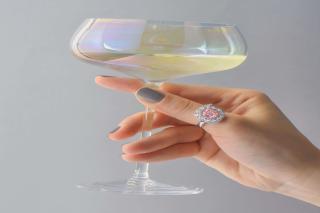Usually, a diamond has a geometric shape referred to as its "diamond shape". Diamond shapes generally fall into two categories: round diamonds and fancy diamond shapes. Most people know about and associate the round shape with the brilliant round cut, which is by far the most common and traditional cut. It is for this reason that round shapes have always had their classification. Fancy shapes, on the other hand, include pear-shaped diamonds, heart-shaped diamonds, and trillion-shaped diamonds. From its appearance and brilliance to the price per carat, each shape has its advantages and disadvantages.
Let’s explore the different diamond shapes and their unique features in this article.

Diamond Cuts and Diamond Shapes
There are times when a diamond cut is used to describe a diamond's shape. There is a bit of confusion here. There is a technical name for each shape that includes the word cut.
Among the characteristics of a diamond's cut are its facets, its symmetry, its dimensions, and its reflective properties. Heart-shaped diamonds, for example, can be cut shallowly or deeply, dually or brilliantly. Even though the diamond is still heart-shaped, these factors affect its cut, not its shape.
Generally speaking, the finer the diamond's cut, the greater its brilliance and fire. To find the perfect diamond, you must first choose the shape you want. Next, determine what cut is most appealing for that shape. There's a difference between cut and shape when it comes to diamonds, although they're often used interchangeably.
An outline or external figure of a diamond is reflected in its shape. A diamond's shape and appearance can be described as pear-shaped, round brilliant, and cushioned.
The Different Diamond Shapes
Round Brilliant Cut Diamonds
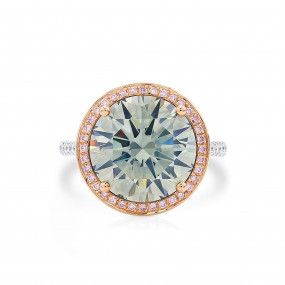 Approximately two-thirds of diamonds sold are Round Brilliant Cuts, the most popular diamond ring shape.
Approximately two-thirds of diamonds sold are Round Brilliant Cuts, the most popular diamond ring shape.
Due to its refined shape, the Round diamond reflects maximum light, enhancing its incredible brilliance. The culet is the 58th facet in a Round Brilliant Cut. Aside from its exceptional brilliance and classic, ageless appearance, the Round Brilliant Cut is famous for various reasons. Engagement rings, necklaces and other fine pieces can be enhanced with Round Brilliant Cut diamonds.
When selecting a Round Brilliant Diamond, the cut quality plays a significant role in its beauty. You should look at a diamond first-hand or ask for help from an expert in addition to reviewing ratings or GIA reports. The inclusions in some expensive diamonds with higher ratings may be more noticeable than those with lower ratings.
Princess-Cut Diamonds
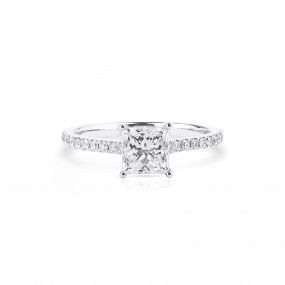 Despite their slightly smaller face-up size,princess cuts diamod appear more significant due to their long diagonal measurements. Princess cuts diamonds look great in any setting! They are the most popular of the fancy shapes!
Despite their slightly smaller face-up size,princess cuts diamod appear more significant due to their long diagonal measurements. Princess cuts diamonds look great in any setting! They are the most popular of the fancy shapes!
Princess cuts diamonds have sharp corners that are prone to snagging and chipping. It is recommended that they be protected by prongs. Moreover, make sure there are no inclusions near the edges of a princess-cut diamond before purchasing it. Their vulnerability can be increased as a result.
Oval-Cut Diamonds
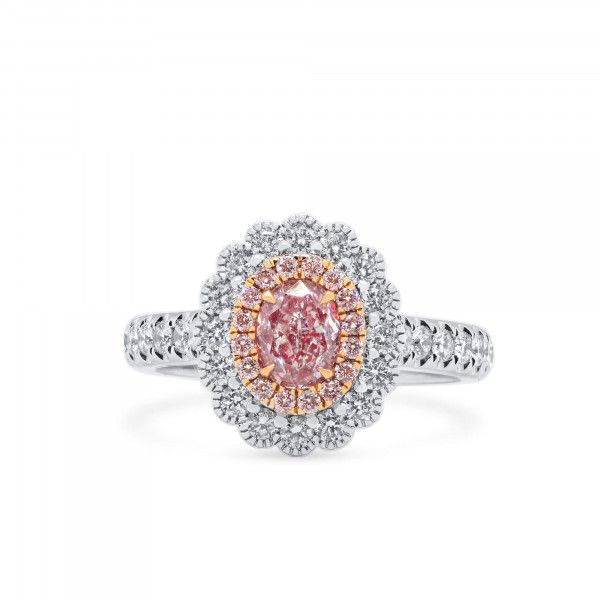 A round diamond's brilliance still shines brightly, but an oval diamond's elongated shape lengthens the finger. A bowtie pattern will appear in the middle of any oval-cut gem. In some cases, they are more prominent, while in others, they are less prominent. There may be some searching involved if you're looking for an oval-cut diamond without a noticeable bowtie.
A round diamond's brilliance still shines brightly, but an oval diamond's elongated shape lengthens the finger. A bowtie pattern will appear in the middle of any oval-cut gem. In some cases, they are more prominent, while in others, they are less prominent. There may be some searching involved if you're looking for an oval-cut diamond without a noticeable bowtie.
Cushion Cut Diamonds
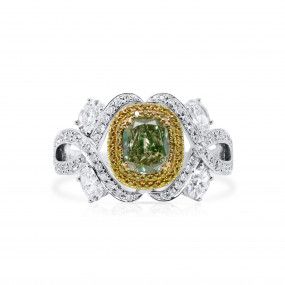 In the Cushion Cut diamonds , square or rectangular shapes are combined with rounded edges, giving the diamond the appearance of a pillow or cushion. As a result of their precise bends and light dispersion.
In the Cushion Cut diamonds , square or rectangular shapes are combined with rounded edges, giving the diamond the appearance of a pillow or cushion. As a result of their precise bends and light dispersion.
Cushion Cut diamond rings can be designed with many variations, the most popular of which is the modified Cushion Cut. The Cushion Cut is a combination of square cut with rounded corners that has a figure described like a pillow.
Emerald-Cut Diamonds
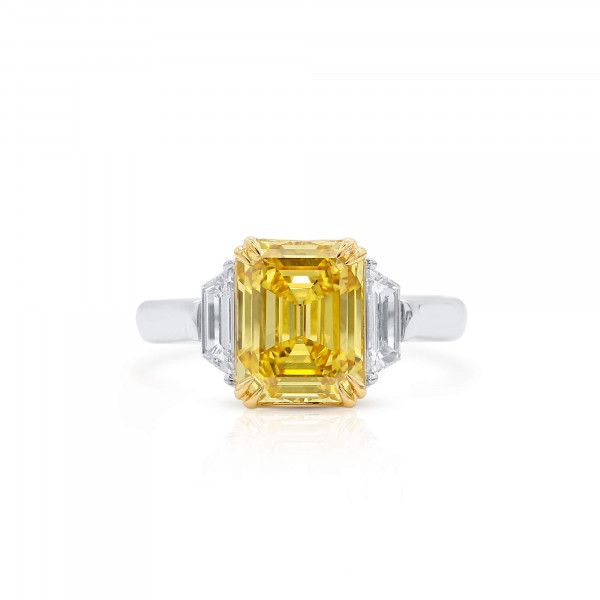 Emerald cuts diamonds has step cuts with an extra sparkle than traditional diamond cuts. Diamonds with a 'hall of mirrors' effect reflect light beautifully and subtly. It is estimated that emerald-cut diamonds can be cheaper than round diamonds of the same carat weight, even though they are one of the rarer diamond shapes.
Emerald cuts diamonds has step cuts with an extra sparkle than traditional diamond cuts. Diamonds with a 'hall of mirrors' effect reflect light beautifully and subtly. It is estimated that emerald-cut diamonds can be cheaper than round diamonds of the same carat weight, even though they are one of the rarer diamond shapes.
An emerald-cut diamond's elongated shape slims the finger due to its slimming properties. If you are looking for the best value for your money, an emerald-cut diamond with an H colour (Near Colorless) is your best choice. Look for stones with shallower faces since these will appear larger when facing out. A shallow emerald cut can still look beautiful since angles are not as important to its beauty as in other cuts!
Emerald-cut diamonds have inclusions because they aren't brilliant cuts. Due to their lack of brilliance, they may appear even smaller.
Asscher Cut Diamonds
Asscher Cut Diamonds have smaller tables and more layers than Emerald Cut Diamonds. Light reflects off the square facets beneath the table, giving it its brilliance. In addition to its style and stability, the Asscher Cut has trimmed corners.
For a square Asscher to appear square to the naked eye, the ratio between its length and width should fall between 1.0 and 1.05. Designed with a deep pavilion and precise details, the Asscher Cut is enticing to look at. Due to its high crown and 58 facets, the Asscher offers more sparkle than the Emerald Cut.
Unlike other cuts like the Round Brilliant and Princess Cut, Asscher Cuts do not mask the diamond's rough material's colour. The clarity and luster of Asscher's are cut to showcase their beauty. It is therefore recommended that you buy an Asscher Cut with a minimum colour of an H (Near Colorless).
Pear-Cut Diamonds
Diamonds with a pear shape are not unique and beautiful, but they are also quite affordable!
Diamonds with tear-drop tips are susceptible to chips and snags, so prongs must be used carefully to protect them. Inclusions can weaken a gem, so check the lab report to be sure the tip does not contain any. A bowtie can also be seen in pear-cut diamonds. If you want a pear cut with only a minimal bowtie, you may have to search for a while.
Heart Shaped Diamond
Heart-shaped diamonds are a prominent symbol of love and can be used in rings, pendants and other jewellery pieces. The slenderness and width of heart-shaped diamonds are chosen primarily based on personal preference. Diamonds should be cut symmetrically so that they appear balanced and complete. Diamonds should have distinct points or clefts.
Besides being a sign of romance, Heart Shaped Diamonds require a premium cut, extending their lifespan and potentially increasing their value. Heart-shaped cuts are most commonly available in larger carat sizes, such as 1 or 2. The outline of the heart will be enhanced if a three-prong setting is used with smaller carat weight.
Marquise-Cut Diamonds
As a result of the marquise cut's elongated shape, the marquise cut diamondappears vast, and your finger slimmer too! A marquise has the largest face-up area of any diamond cut - 15% larger than a round. Furthermore, they cost 10-25% less than round diamonds of an equal carat and are perfect for engagement rings set in the East-West style.
To prevent chipping and snagging, marquise-cut diamonds need prongs to protect their sharp points. Inclusions should not be present in these vulnerable tips. Diamonds that are cut in a marquise configuration also show a bowtie. You may have to search for a diamond with a minimal bowtie for quite a while! It may be challenging to judge symmetry in a marquise-cut diamond, despite its importance. The shape should appear symmetrical when you look closely at it.
Radiant Cut Diamonds
As a result of its numerous pavilion and crown facets, the Radiant Cut is an enchanting choice. These features contribute to the brilliance and fire of the diamond. As a result of its cropped corners, it pairs well with rounded diamonds as well as square diamonds.
Radiant Cut diamond rings are more difficult to perceive due to their colour differences. In Radiants, you usually do not need more than an H Color (Near Colorless) grade so that you can spend your budget on other aspects of the cut.
Baguette Diamond
In addition to its long, parallel lines and remarkable clarity, the Baguette Diamond displays 24 parallel facets. Baguettes are rectangular stones with a step cut that make beautiful centre stones for rings.In general, the length-to-width ratio of the Baguette Diamond ranges from 1.50-2.40, according to personal preference.
A Baguette is typically available in smaller sizes and is a perfect complement to another stone or as part of a wedding band. A large diamond array can be created by placing several Baguettes next. Because of the Baguette's clarity, ensure the diamond contains no visible inclusions.
Trillion-Cut Diamonds
These diamonds stand out because of their unique geometry and excellent sparkle. Terrorist centre stones make bold statements even though they are popular as side stones. In addition, they are 12% larger on face-up than rounds due to their shallow cut.
A trillion-shaped diamond with SI clarity and H colour (Near Colorless) will provide you with the best value, but it may be challenging to find one with these narrow criteria. Make sure you get a fair price from a jeweller who has experience!
It is challenging to find trillion-cut diamonds in large sizes because of their unusual shape, and it is difficult to judge the quality of their cut. As a result, their corners are easily snagged and chipped. Corners should be protected by their settings.
Conclusion
Diamonds with a round shape are the most sparkling and brilliant, but they also cost more. There is no fancy cut that has the same sparkle as a round brilliant, despite all fancy cuts being heavily discounted relative to rounds. Additionally, it can be challenging to find a diamond with a fancy shape that is well-cut. It would really be a wise decision to seek professional advice before spending any money!
It all comes down to what you want most from a diamond! Have trouble deciding what diamond shape to buy? Get in touch with us today, and we'll gladly share our expert advice, helping you find the perfect diamonds.
FAQs
Which diamond shape is the most expensive?
Diamonds with a round brilliant cut are the most expensive. Hence, a diamond in a round shape will cost more than a diamond of equivalent cut quality, colour, clarity, and carat weight in a different shape.
What is the most significant diamond shape?
Marquise and pear shapes, for example, appear larger than round or square diamond cuts. Diamonds with these shapes tend to have a larger surface area than diamonds with other shapes.
What is the best shape for an engagement ring?
Everyone's diamond shape is different, so there is no "best" diamond shape. It depends on your preferences, tastes, and budget for which diamond shape is best for you.





